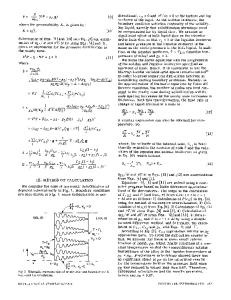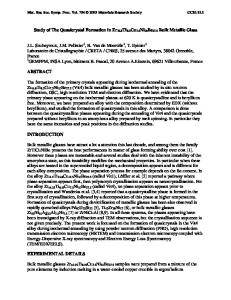Glass and Quasicrystal Formation in a Zr-based Multicomponent Alloy
- PDF / 4,442,943 Bytes
- 6 Pages / 595 x 842 pts (A4) Page_size
- 38 Downloads / 295 Views
Glass and Quasicrystal Formation in a Zr-based Multicomponent Alloy U. Kühn, J. Eckert, N. Mattern and L. Schultz IFW Dresden, P.O.Box 270016, D-01171 Dresden, Germany ABSTRACT The phase formation of a Zr57Ti8Nb2.5Cu13.9Ni11.1Al7.5 alloy has been investigated upon cooling from the melt at different quenching rates as well as upon annealing of as-cast specimens. The different samples are characterized by x-ray diffraction, transmission electron microscopy and differential scanning calorimetry. Rapid quenching using the melt spinning technique results in amorphization. Slower cooling as realized upon copper mold casting leads to an icosaheadral quasicrystalline phase coexisting with a small amount of amorphous phase. The primarily formed quasicrystals have a grain size of about 1 µm. Upon annealing, the amorphous phase formed upon melt spinning precipitates quasicrystals in the first step of a series of transformations to the crystalline equilibrium compounds. The quasicrystals formed by annealing do not exceed a size of 5 to 10 nm.
INTRODUCTION It has been reported that Zr-based multicomponent alloys with a high glass-forming ability and a large supercooled liquid region [1] can be prepared with thicknesses up to 30 mm by slow cooling from the melt [2]. These Zr-based alloys contain nickel, copper, aluminum [3,4] and other additions like Ti, Nb or Be [5], and their properties, such as the mechanical properties [6,7] and the electrochemical behavior [8] were investigated in a series of papers. In addition to bulk glass formation it is known that some of these alloy systems, e.g. Zr-Cu-Ni-Al [9], Zr-Ti-Ni-Cu-Al [10], Zr-Al-Ni-Cu-Ag [11] and Zr-Al-Ni-Cu-Pd [12] can be transformed into an icosahedral quasicrystalline phase by annealing the amorphous phase. An icosahedral phase can also be formed directly from the liquid by melt spinning in some alloy systems such as Zr41.5Ti41.5Ni17 [13], Ti-based alloys [14] and Zr-based alloys with Be addition [15]. The quasicrystalline phases exhibit interesting properties, such as high hardness and strengh, good wear and corrosion resistance etc. [16]. This paper is to report investigations on the solidification behavior of a Zr-Ti-Nb-CuNi-Al alloy. The formation of an amorphous, a quasicrystalline or a crystalline phase can be observed by quenching from the liquid state depending on the actual cooling rate applied. Moreover, nanoscale quasicrystalline particles can be formed upon primary quasicrystallization of melt-spun amorphous ribbons.
EXPERIMENTAL An ingot of nominal composition Zr57Ti8Nb2.5Cu13.9Ni11.1Al7.5 was prepared by arc melting in a high purity argon atmosphere (99.9999 % purity). From this alloy ingot, bulk specimens were prepared by injection casting into a copper mold in a purified argon atmosphere. In this investigation the bulk specimens in form of cylindrical rods are 50 mm in length and 3 or 5 mm in diameter in order to achieve different cooling rates upon solidification. There is also a gradient of the cooling rate within the bulk cylinders, an influence of th
Data Loading...











